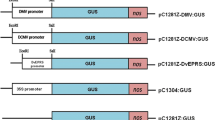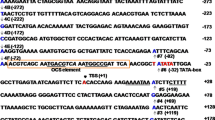Abstract
Figwort mosaic virus (FMV) is a caulimovirus with a circular double-stranded DNA genome of about 8 kilobase pairs (kbp) (Richins et al., 1987). Like CaMV, the genome is expressed as two sets of genes (Gowda et al., 1989). The first set consists of a group of six genes (VII and I through V) closely spaced on a major polycistronic transcript which spans the entire viral genome. The second set consists of gene VI which has its own promoter and is transcribed as a separate monocistronic transcript (Fig. 1). This suggests that gene VI may have some early function in the replication cycle. The product of this gene of FMV accumulates in viral inclusion bodies, similar to those of cauliflower mosaic virus (CaMV), the type member of caulimovirus group. Although the role of gene VI of CaMV in disease induction and the host range determination is well documented (Daubert et al., 1984; Schoelz et al., 1986)), its molecular function has only recently been studied. As presented here and by Hohn et al., for CaMV in this volume, as well as a previous report (Hohn et al., 1989), gene VI appears to activate the expression of internal genes of the polycistronic transcript. This role has been demonstrated by the electroporation of viral genome-reporter gene constructs into plant protoplasts. For example, a plasmid containing the promoter of the major RNA transcript, the long intergenic region and gene VII (Fig. 2) followed by the chloramphenicol acetyltransferase (CAT) gene as a downstream cistron, shows little CAT activity following electroporation into plant protoplasts unless a separate plasmid expressing gene VI of FMV is included in the electroporation mixture.
Access this chapter
Tax calculation will be finalised at checkout
Purchases are for personal use only
Preview
Unable to display preview. Download preview PDF.
Similar content being viewed by others
References
Baughman, G., Howell, S.H. (1988). Cauliflower mosaic virus 35S RNA leader region inhibits translation of downstream genes. Virology 167: 125–135.
Daubert, S.D., Schoelz, J., Li, D. and Shepherd, R.J. (1984). Expression of disease symptoms in cauliflower mosaic virus genomic hybrids. Jour. Mol. Appl. Genet. 2: 537–547.
Futterer, J., Gordon, K., Bonneville, J.M., Sanfacon, H., Pisan, B., Penswick, J., Hohn, T. (1988). The leading sequence of caulimovirus large RNA can be folded into a large stem-loop structure. Nucleic Acids Res 16: 8377–8390.
Gowda, S., Wu, F.C., Shepherd, R.J. (1989). Identification of promoter sequences for the major RNA transcripts of figwort mosaic virus and peanut chlorotic streak virus. J Cell Biochem 13-D (supp.) 301.
Gowda, S., Wu, F. C., Scholtof, H. B., Shepherd, R. J. (1989). Gene VI of figwort mosaic virus (caulimovirus group) functions in transcriptional expression of genes on the full-length RNA transcript. Proc. Natl. Acad. Sci. USA 86: 9203–9207
Hohn, T., Bonneville, J.M., Futterer, J., Gordon, K., Pisan, B., Sanfacon, H., Schultze, M., Jiricny, J. (1989). The first thousand and one nucleotides of genomic CaMV RNA. In Molecular Biology of Plant-Pathogen Interactions. UCLA Symposium on Molecular and Cellular Biology, (eds. Saskawicz, B., Ahlquist, P., Yoder, O.) Alan R. Liss. New York, pp.153–165.
Kozak, M. (1986). Point mutations define a sequence flanking the AUG initiator codon that modulates translation by eukaryotic ribosomes. Cell 44: 283–292.
Richins, R.D., Scholthof, H.B., Shepherd, R.J. (1987). Sequence of figwort mosaic virus DNA (caulimovirus group) Nucleic Acids Res 15: 8451–8466.
Schardl, C.L., Byrd, A.D., Benzion, G., Altschuler, M.A., Hildebrand, D.F. and Hunt, A.G. (1987). Design and construction of a versatile system for the expression of foreign genes in plants. Gene 61: 1–11.
Schoelz, J.E., Shepherd, R.J., Daubert, S. (1986). Region VI of cauliflower mosaic virus encodes a host range determinant. Molec Cell Biol 6: 2632–2637.
Scholthof H., Richins R.D., Handley M. K., Shepherd R. J., (1986). Nucleotide sequence of a naturally occuring deletion mutant of figwort mosaic virus. Phytopathology 76: 1131.(Abst.)
Author information
Authors and Affiliations
Editor information
Editors and Affiliations
Rights and permissions
Copyright information
© 1990 Springer-Verlag New York Inc.
About this paper
Cite this paper
Gowda, S., Wu, F.C., Scholthof, H., Shepherd, R.J. (1990). Gene VI of Figwort Mosaic Virus Activates Expression of Internal Cistrons of the Full-length Polycistronic RNA Transcript. In: Pirone, T.P., Shaw, J.G. (eds) Viral Genes and Plant Pathogenesis. Springer, New York, NY. https://doi.org/10.1007/978-1-4612-3424-1_9
Download citation
DOI: https://doi.org/10.1007/978-1-4612-3424-1_9
Publisher Name: Springer, New York, NY
Print ISBN: 978-1-4612-8006-4
Online ISBN: 978-1-4612-3424-1
eBook Packages: Springer Book Archive




